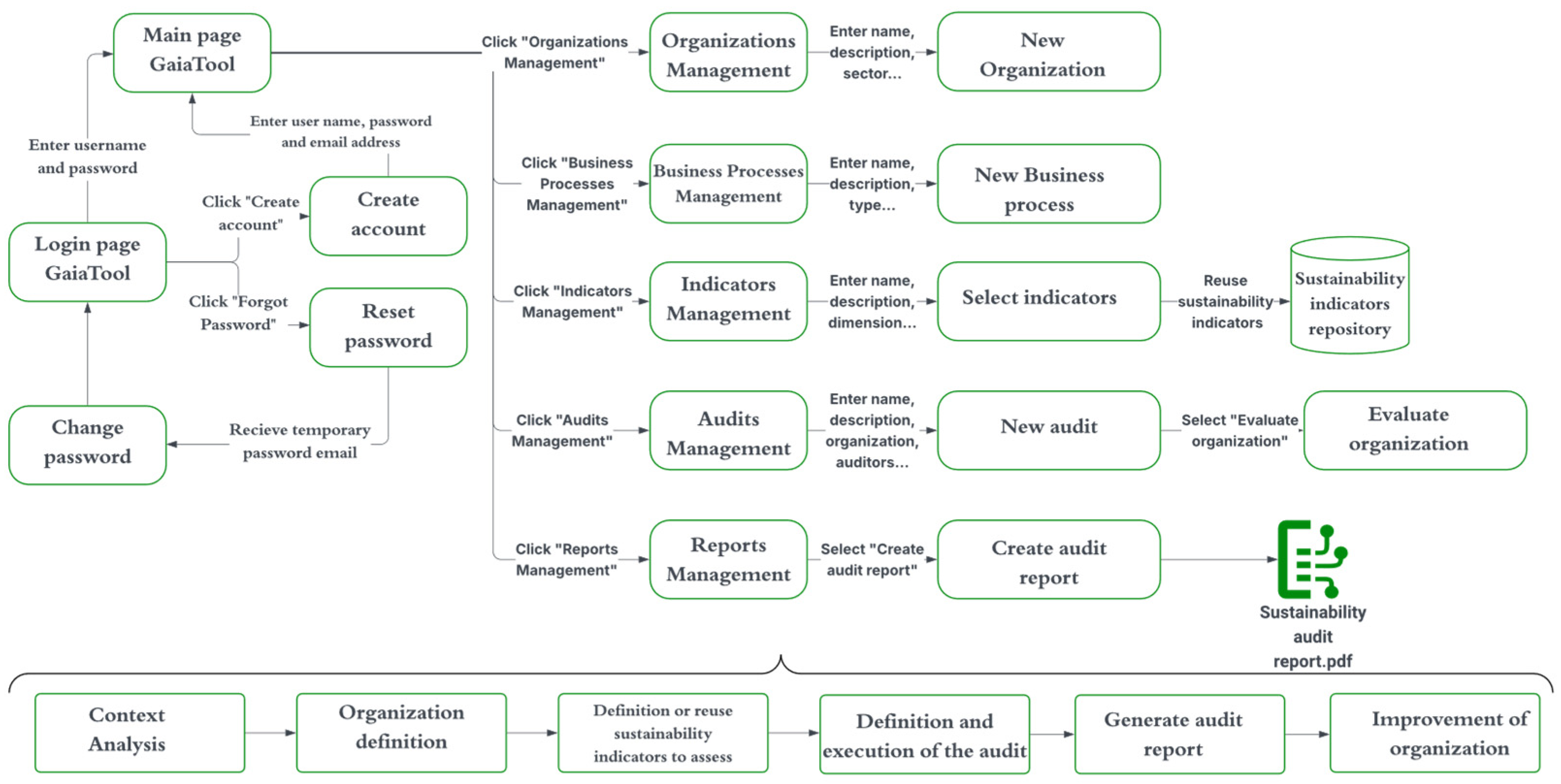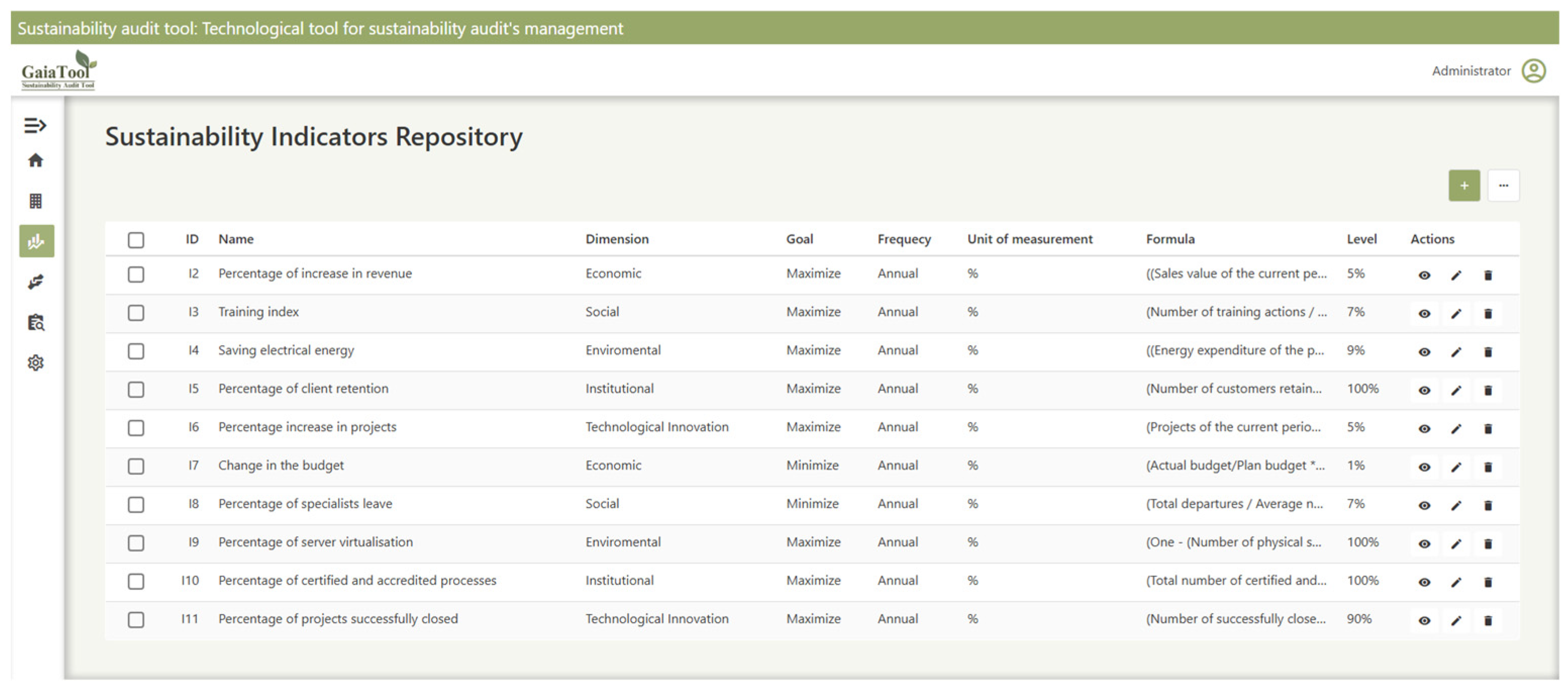Measuring Sustainability Through Business Processes with GaiaTool †
Abstract
1. Introduction
2. GaiaTool
2.1. Overview
2.2. Case Study
2.3. Sustainability Evaluation with GaiaTool
2.3.1. Context Analysis
2.3.2. Organization Definition
2.3.3. Definition or Reuse of Sustainability Indicators
2.3.4. Definition and Execution of the Audit
2.3.5. Generate Audit Report
2.3.6. Improvement of Organization
3. Related Work
4. Conclusions and Further Work
Author Contributions
Funding
Institutional Review Board Statement
Informed Consent Statement
Data Availability Statement
Conflicts of Interest
References
- Esquer-Peralta, J.; Velazquez, L.; Munguia, N. Perceptions of core elements for sustainability management systems (SMS). Manag. Decis. 2008, 46, 1027–1038. [Google Scholar] [CrossRef]
- Sohns, T.M.; Aysolmaz, B.; Figge, L.; Joshi, A. Green business process management for business sustainability: A case study of manufacturing small and medium-sized enterprises (SMEs) from Germany. J. Clean. Prod. 2023, 401, 136667. [Google Scholar] [CrossRef]
- Hörisch, J.; Ortas, E.; Schaltegger, S.; Álvarez, I. Environmental effects of sustainability management tools: An empirical analysis of large companies. Ecol. Econ. 2015, 120, 241–249. [Google Scholar] [CrossRef]
- Mahapatra, S.K.; Schoenherr, T.; Jayaram, J. An assessment of factors contributing to firms’ carbon footprint reduction efforts. Int. J. Prod. Econ. 2021, 235, 108073. [Google Scholar] [CrossRef]
- Ness, B.; Urbel-Piirsalu, E.; Anderberg, S.; Olsson, L. Categorising tools for sustainability assessment. Ecol. Econ. 2007, 60, 498–508. [Google Scholar] [CrossRef]
- Searcy, C. Updating corporate sustainability performance measurement systems. Meas. Bus. Excell. 2011, 15, 44–56. [Google Scholar] [CrossRef]
- Dahl, A.L. Achievements and gaps in indicators for sustainability. Ecol. Indic. 2012, 17, 14–19. [Google Scholar] [CrossRef]
- Opitz, N.; Krüp, H.; Kolbe, L.M. Environmentally sustainable business process management—Developing a green BPM readiness model. In Proceedings of the 18th Pacific Asia Conference on Information Systems, PACIS 2014, Chengdu, China, 24–28 June 2014. [Google Scholar]
- Van Bellen, H.M. Desenvolvimento sustentável: Uma descrição das principais ferramentas de avaliação. Ambiente Soc. 2004, 7, 67–87. [Google Scholar] [CrossRef]
- González, L.S.; Rubio, F.G.; González, F.R.; Velthuis, M.P. Measurement in business processes: A systematic review. Bus. Process Manag. J. 2010, 16, 114–134. [Google Scholar] [CrossRef]
- Berrone, P.; Rousseau, H.E.; Ricart, J.E.; Brito, E.; Giuliodori, A. How can research contribute to the implementation of sustainable development goals? An interpretive review of SDG literature in management. Int. J. Manag. Rev. 2023, 25, 318–339. [Google Scholar] [CrossRef]
- Pádua, S.I.D.; Jabbour, C.J.C. Promotion and evolution of sustainability performance measurement systems from a perspective of business process management: From a literature review to a pentagonal proposal. Bus. Process Manag. J. 2015, 21, 403–418. [Google Scholar] [CrossRef]
- Venn, R.; Perez, P.; Vandenbussche, V. Competencies of Sustainability Professionals: An Empirical Study on Key Competencies for Sustainability. Sustainability 2022, 14, 4916. [Google Scholar] [CrossRef]
- Büyüközkan, G.; Karabulut, Y. Sustainability performance evaluation: Literature review and future directions. J. Environ. Manag. 2018, 217, 253–267. [Google Scholar] [CrossRef] [PubMed]
- Maciel, J.C. The Core Capabilities of Green Business Process Management—A Literature Review. In Proceedings of the 13th International Conference on Wirtschatsinformatik (WI 2017), St. Gallen, Switzerland, 12–15 February 2017; pp. 1526–1537. Available online: https://pdfs.semanticscholar.org/ff31/a48a204e85ff3d13d6c76edf5f7ae17f777d.pdf%0Ahttp://www.wi2017.ch/de/proceedings (accessed on 3 April 2025).
- Grecu, V.; Ciobotea, R.I.G.; Florea, A. Software application for organizational sustainability performance assessment. Sustainability 2020, 12, 4435. [Google Scholar] [CrossRef]
- Čuček, L.; Klemeš, J.J.; Kravanja, Z. A review of footprint analysis tools for monitoring impacts on sustainability. J. Clean. Prod. 2012, 34, 9–20. [Google Scholar] [CrossRef]
- Balcioglu, G.; Fitzgerald, A.M.; Rodes, F.A.M.; Allen, S.R. Data quality and uncertainty assessment of life cycle inventory data for composites. Compos. B Eng. 2025, 292, 112021. [Google Scholar] [CrossRef]
- Silvast, A. Measuring Business Impacts in Small Business: Case B-Impact Assessment Tool; Vaasan Ammattikorkeakoulu: Vaasa, Finland, 2018. [Google Scholar]



Disclaimer/Publisher’s Note: The statements, opinions and data contained in all publications are solely those of the individual author(s) and contributor(s) and not of MDPI and/or the editor(s). MDPI and/or the editor(s) disclaim responsibility for any injury to people or property resulting from any ideas, methods, instructions or products referred to in the content. |
© 2025 by the authors. Licensee MDPI, Basel, Switzerland. This article is an open access article distributed under the terms and conditions of the Creative Commons Attribution (CC BY) license (https://creativecommons.org/licenses/by/4.0/).
Share and Cite
Sobrino-Duque, R.; Plasencia Soler, J.A.; Moros Valle, B.; Ros, J.N. Measuring Sustainability Through Business Processes with GaiaTool. Eng. Proc. 2025, 112, 13. https://doi.org/10.3390/engproc2025112013
Sobrino-Duque R, Plasencia Soler JA, Moros Valle B, Ros JN. Measuring Sustainability Through Business Processes with GaiaTool. Engineering Proceedings. 2025; 112(1):13. https://doi.org/10.3390/engproc2025112013
Chicago/Turabian StyleSobrino-Duque, Raimel, Juan A. Plasencia Soler, Begoña Moros Valle, and Joaquín Nicolás Ros. 2025. "Measuring Sustainability Through Business Processes with GaiaTool" Engineering Proceedings 112, no. 1: 13. https://doi.org/10.3390/engproc2025112013
APA StyleSobrino-Duque, R., Plasencia Soler, J. A., Moros Valle, B., & Ros, J. N. (2025). Measuring Sustainability Through Business Processes with GaiaTool. Engineering Proceedings, 112(1), 13. https://doi.org/10.3390/engproc2025112013





